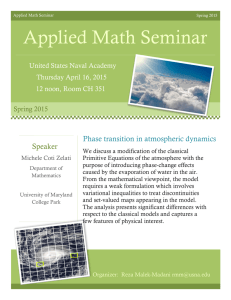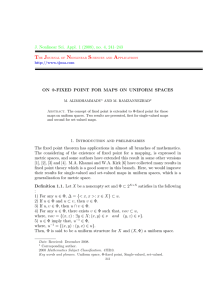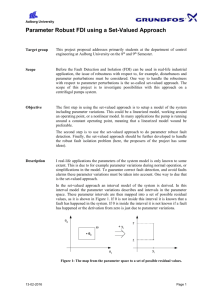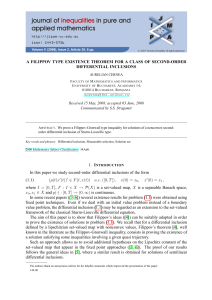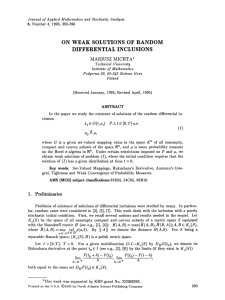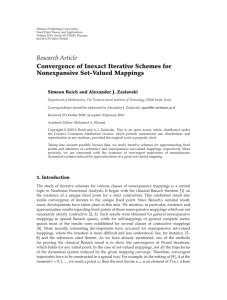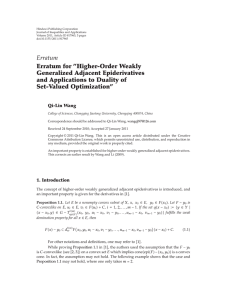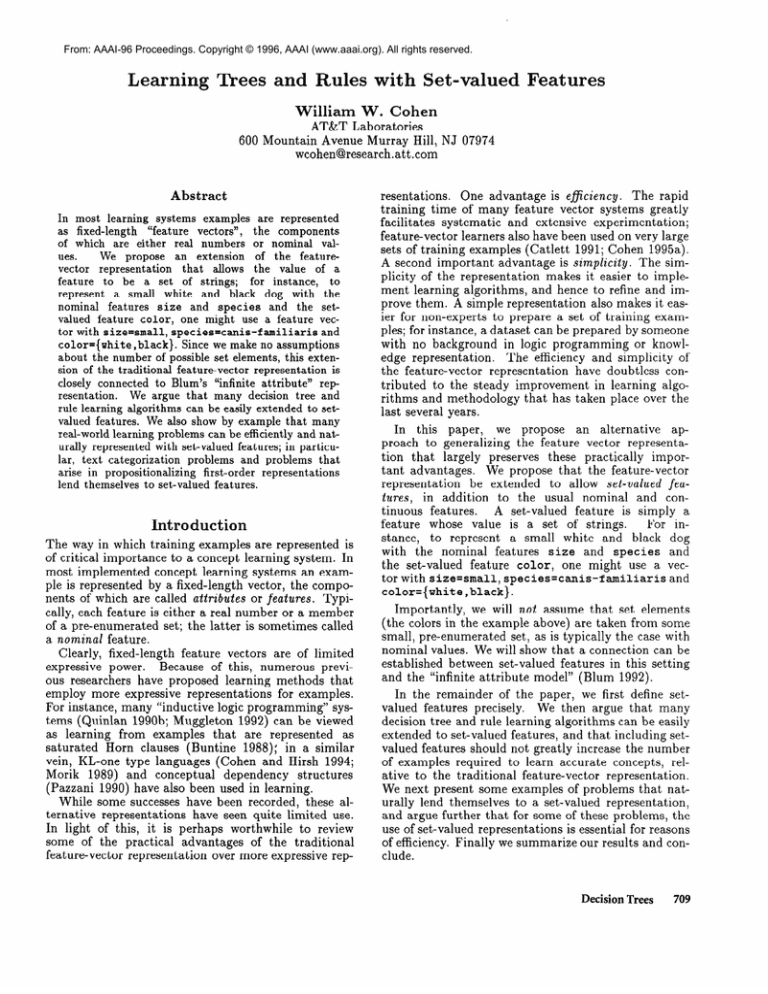
From: AAAI-96 Proceedings. Copyright © 1996, AAAI (www.aaai.org). All rights reserved.
Learning Trees an
ules with Set-val
William
W.
ed Features
Cohen
AT&T Laboratories
600 Mountain Avenue Murray Hill, NJ 07974
wcohen@research.att.com
Abstract
In most learning systems
examples
are represented
as fixed-length
“feature
vectors”,
the components
of which are either real numbers
or nominal
values.
W e propose
an extension
of the featurevector
representation
that allows
the value of a
feature
to be a set of strings;
for instance,
to
represent
a small white
and black
dog with the
nominal
features
size
and species
and the setvalued feature color,
one might use a feature vector with size=small,
species=canis-f
amiliaris
and
color={
white, black}.
Since we make no assumptions
about the number of possible set elements, this extension of the traditional
feature-vector
representation
is
closely connected
to Blum’s
“infinite attribute”
rep
resentation.
We argue that many decision
tree and
rule learning algorithms
can be easily extended to setvalued features.
We also show by example that many
real-world learning problems can be efficiently and naturally represented with set-valued features; in particular, text categorization
problems
and problems
that
arise in propositionalizing
first-order
representations
lend themselves to set-valued features.
Introduction
The way in which training examples are represented
is
of critical importance
to a concept learning system. In
most implemented
concept learning systems an example is represented
by a fixed-length
vector, the components of which are called attributes
or features.
Typically, each feature is either a real number or a member
of a pre-enumerated
set; the latter is sometimes called
a nominal feature.
Clearly, fixed-length
feature vectors are of limited
expressive
power.
Because of this, numerous
previous researchers
have proposed learning methods that
employ more expressive representations
for examples.
For instance, many “inductive logic programming”
systems (Quinlan
1990b; Muggleton
1992) can be viewed
as learning
from examples
that are represented
as
saturated
Horn clauses (Buntine
1988); in a similar
vein, KL-one type languages
(Cohen and Hirsh 1994;
Morik 1989) and conceptual
dependency
structures
(Pazzani 1990) have also been used in learning.
While some successes have been recorded, these alternative
representations
have seen quite limited use.
In light of this, it is perhaps worthwhile
to review
some of the practical
advantages
of the traditional
feature-vector
representation
over more expressive rep-
resentations.
One advantage
is eficiency
. The rapid
training
time of many feature vector systems greatly
facilitates
systematic
and extensive
experimentation;
feature-vector
learners also have been used on very large
sets of training examples (Catlett
1991; Cohen 1995a).
A second important
advantage
is simplicity.
The simplicity of the representation
makes it easier to implement
learning
algorithms,
and
hence
to refine
and
im-
prove them. A simple representation
also makes it easier for non-experts
to prepare a set of training examples; for instance, a dataset can be prepared by someone
with no background
in logic programming
or knowledge representation.
The efficiency and simplicity
of
the feature-vector
representation
have doubtless
contributed
to the steady improvement
in learning algorithms and methodology
that has taken place over the
last several years.
In this paper,
we propose
an alternative
approach to generalizing
the feature vector representation that largely preserves
these practically
important advantages.
We propose that the feature-vector
representation
be extended
to allow set-valued
feain addition
to the usual nominal
and contures,
tinuous
features.
A set-valued
feature is simply a
feature
whose value is a set of strings.
For instance,
to represent
a small white and black dog
with the nominal
features
size
and species
and
the set-valued
feature color,
one might use a vector with size=small,
species=canis-familiaris
and
color={white,black}.
Importantly,
we will not assume that set elements
(the colors in the example above) are taken from some
small, pre-enumerated
set, as is typically the case with
nominal values. We will show that a connection
can be
established
between set-valued
features in this setting
and the “infinite attribute
model” (Blum 1992).
In the remainder
of the paper, we first define setvalued features precisely.
We then argue that many
decision tree and rule learning algorithms can be easily
extended to set-valued features, and that including setvalued features should not greatly increase the number
of examples required to learn accurate concepts,
relative to the traditional
feature-vector
representation.
We next present some examples of problems that naturally lend themselves
to a set-valued
representation,
and argue further that for some of these problems, the
use of set-valued representations
is essential for reasons
of efficiency. Finally we summarize our results and conclude.
DecisionTrees
709
Set-valued
features
function MaxGainTest(S,
In the interests of clarity we will now define our proposed extension
of the feature vector representation
A domain
D = (7-h,< il, V, Y) conmore precisely.
sists of a dimension
n, a type vector 3 = (tl, . . . , t,),
a name
(vl,-.,K>,
vector
ii =
(ul,
, . . , u,),
a value
vector
P =
and a class set Y = (~1,. . . ,gk}. Each
component
ti of the type vector ?must
be one of the
symbols cant inuous,
nominal,
or set.
Each component ui of the name vector u’must be a string over the
alphabet C. (Here C is a fixed alphabet, such as (0, 1)
Vi
or {a,. . . , z}.) The class set Y and the components
of the value vector 7 are sets of strings over C. Intuitively, a “domain” formalizes the sort of information
about a learning problem that is recorded by typical
feature-vector
learners such as C4.5 (Quinlan
1994)with the addition of the new feature type set.
Using domains we can define the notion of a “leA legal example
of the domain D =
gal example”.
(n, <, Z, c, Y) is a pair (Z, y) where Z is a legal instance
and y E Y. A legal instance of the domain D is a vector Z= (XI,...,
x~) where for each component
xi of Z,
(a) if ti = continuous
then xi is a real number; (b) if
then xi E V;: (otherwise,
if ti # nominal,
ti = nominal
the value of V;: is irrelevant);
(d) if ti = set then xi is
a set of strings over C, i.e., xi = (~1,. . . , sul}.
Finally, we will define certain primitive tests on these
instances.
If ui is a component
of the name vector c,
T is a real number and s is a string, then the following
are all primitive
tests for the domain D: ui = s and
ui # s for a nominal feature ui; ui 5 r and ui 2 r for
a continuous
feature ui; and s E u; and s @ ui for a
set-valued feature ui. The semantics of these primitive
tests are all defined in the obvious way-for
instance,
if ua = color, then “puce E color”
denotes the set of
legal instances Ic’= (xl,. . . , x~) such that puce E x3.
Boolean combinations
of primitive tests are also defined in the obvious way. We can now speak precisely of
representations
such as DNF, decision trees, or decision
lists over set-valued representations.
Implementing
Set-Valued
Features
Let us now consider the problem of learning decision
trees for the representation
described above-that
is,
for feature vector examples that contain a mix of setvalued, nominal and continuous features. As a concrete
case, we will consider how the ID3 algorithm
(Quinlan
1990a) can be extended to allow internal nodes to be
labeled with element-of
tests of the form s E ui and
s $! u; on set-valued
features ui, in addition
to the
usual tests on continuous
or nominal features.
To implement
this extension of ID3, it is clearly necessary and sufficient to be able to find, for a given setvalued feature ui and a given set of examples S, the
element-of test s E ui or s $ ui that maximizes entropy
on S. Figure 1 presents a function MaxGainTest
that
finds such a maximizing
test. For simplicity, we have
assumed that there are only two classes.
710
Learning
1
2
3
4
5
6
7
8
9
10
11
12
13
14
15
16
17
18
19
20
21
22
23
24
25
26
i)
Visited := 0;
TotalCount[+]:=O;
TotalCount[-]:=O;
for each example (Z, y) in the sample S do
for each string s E zL do
Visited := Visited U(s);
ElemCount[s,
y] := ElemCount[s,
y]+l;
endfor
TotalCount[y]
:= TotalCount[y]+l;
endfor
BestEntropy
= -1;
for each s E Visited do
p := ElemCount[s,+];
n := ElemCount[s,-1;
if (Entropy(p,
n) > BestEntropy)
then
BestTest := “3 E uc”;
:= Entropy(p, n);
BestEntropy
endif
p’ := TotalCount[+]
- ElemCount[s,+];
12’:= TotalCount[--]
- ElemCount[s,-1;
if (Entropy@‘,
n’) > BestEntropy)
then
BestTest := “s @ Us”;
:= Entropy@‘,
n’);
BestEntropy
endif
ElemCount[s,+]
:= 0;
ElemCount[s,-]
:= 0
endfor
return BestTest
Figure
1: Finding
the best element-of
test
Lines l-9 of the function loop over the examples in
the sample, and record, for each string s that appears
as an element of the i-th feature of an example. the
number of times that s appears in a positive example,
and the number of times that s appears in a negative
example. These counts are stored in ElemCount Cs, +3
and ElemCount Cs, -1. (These counters are assumed to
be initialized
to zero before the routine is called; they
are reset to zero at line 20.) Additionally,
a set Visited
of all the elements s that appear in feature i of the
sample is maintained,
and the total number of positive
and negative examples is recorded in TotalCount
[+I
and TotalCount
C-l.
Lines lo-25 make use of these counts to find the best
For a given set element s, the number of extest.
amples of class y covered by the test s E ui is simply ElemCount Cs, yl ; similarly
the number
of examples of class
by TotalCount
y covered
by the test s $ ui is given
CT-J]
-ElemCount
[s, yl . The maximal
en-
tropy test can thus be found by looping over the elements s in the set Visited,
and computing
the entropy
of each test based on these formulae.
A few points regarding this procedure bear mention.
Deficiency. Defining the size of a sample in the natural way, it is straightforward
to argue that if accessing ElemCount and the Visited
set requires constant
time,l
then invoking MaxGainTest
for all set-valued
features of a sample only requires time linear in the to‘In a batch setting, when all the string constants
are
known in advance, is it trivial to implement
constant-time
access procedures
for ElemCount and Visited.
One simple
technique is to replace every occurrence
of a string s in the
tal size of the sample. 2 Hence finding maximal-entropy
element-of tests can be done extremely efficiently. Notice that this time bound is independent
of the number
of different strings appearing
as set elements.
“iWonotone”
element-of
tests. One could restrict this
procedure to generate only set-valued tests of the form
“s E ui” by simply removing lines 15-19. Henceforth,
we will refer to these tests as monotone
element-of
tests.
Theory, as well as experience
on practical
problems,
indicates that this restriction
may be useful.
Generality.
This routine can be easily adapted to
maximize a metric other than entropy, such as the GIN1
criteria (Brieman et al. 1984), information
gain (Quinlan 1990b), predictive value (Apt6 et al. 1994), BayesLaplace corrected error (Clark and Niblett 1989), or
LS-content
(Ali and Pazzani 1993). In fact, any metric
that depends only on the empirical performance
of a
condition on a sample can be used. Hence it is possible
to extend
algorithm
rule sets.
to set-valued
for building
A Theory
features
decision
virtually any top-down
trees, decision
lists, or
Of Set-Valued
Features
Given that it is possible to extend a learning system to
set-valued features, the question remains, is it useful?
It might be that few real-world problems can be naturally expressed with set-valued features.
More subtly,
it might be that learning systems that use set-valued
features tend to produce hypotheses that generalize relatively poorly.
The former question will be addressed later. In this
section we will present some formal results that suggest
that extending
a boolean hypothesis
space to include
element-of tests on set-valued features should not substantially
increase the number of examples needed to
learn accurate concepts.
In particular,
we will relate
the set-valued attribute
model to Blum’s (1992) “infinite attribute
space” model, thus obtaining
bounds on
the sample complexity required to learn certain boolean
combinations
of element-of tests.
In the infinite attribute
space model of learning, an
large (possibly infinite) space of boolean attributes
A is
assumed. This means that an instance can no longer be
represented as a vector of assignments
to the attributes;
instead, an instance is represented
by a list of all the
attributes
in A that are true for that instance.
The size
dataset with a unique small integer, called the index of s.
Then ElemCount can be a T x k matrix of integers, where T is
the largest index and k is the number of classes. Similarly,
Visited
can be a single length-r
array of flags (to record
what has been previously
stored in Visited)
and another
length-r array of indices.
*A brief argu ment: any invocation
of MaxGainTest,
the
number of times line 5 is repeated is bounded by the total
size of the i-th features of examples in the sample, and the
number of iterations of the for loop at lines lo-21 is bounded
by the size of Visited,
which in turn is bounded
by the
number of repetitions
of line 5.
of an instance is defined
in this list.
One can represent
nite
attribute
model
to be the number
of attributes
an
in
with
instance
a single
I
set-valued
the
infi-
feature
true-attribs,
whose value is the set of attributes
true
for I. If I’ is the set-valued representation
of I, then
the element-of test “aj E true-attribs”
succeeds for
I’ exactly when the boolean attribute
aj is true for I,
and the test “aj $ true-attribs”
succeeds for I’ exactly when aj is false for 1.
Conversely, given an instance I represented
by the n
set-valued features ur , . . . , u,, one can easily construct
an equivalent
instance in the infinite attribute
model:
for each set-valued feature ui and each possible string
s-in-ui be true precisely when
c E C*, let the attribute
the element-of test “s E ui” would succeed. This leads
to the following observation.
Observation
1 Let D = (n,< ii, c, Y = {+, -})
be
and set-valued
feaa domain
contuining
only nominal
tures, and let ,C be any language of boolean combinations
of primitive
tests on the features
in ii.
Then there exists a boolean language &’ in the infinate attribute
model, a one-to-one
mappang fI from legal instances
of D to instances
in the infinite attribute
model, and a one-to-one
mappang fc from concepts
an
l to concepts
in .C’ such that
v’c E L
(I E C) e (fI(1) E fc(C))
In other words, if one assumes there are only two
classes and no continuous
features,
then every setvalued feature domain D and set-valued
feature language l has an isomorphic formulation
in the infinite
attribute
model.
This observation
allows one to immediately
map over
results from the theory of infinite attributes,
such as the
following:
Corollary 2 Let D be a two-class
domain
containing
only set-valued
features,
but containing
any number of
these.
Let n be an upper bound on the size of legal
instances
of D. Let Lk be the language of conjunctions
of at most k element-of
tests, let MI, be the language
of conjunctions
of at most k monotone
element-of
tests,
and let VCdim(*)
denote the Vapnik-Chervonenkis
(VC) dimension
of a language.
Then
e
e
VCdim(Lk)
VCdim(Mk)
5 (n + l)(k + 1);
5 n + 1, irrespective
of k.
Proof: Immediate
consequence of the relationships
between mistake bounds and VC-dimension
established
by Littlestone
(1988) and Theorems
1 and 2 of Blum
(1992).
Together with the known relationship
between VCdimension
and sample complexity,
these results give
some insight into how many examples should be needed
to learn using set-valued
features.
In the monotone
case, conjunctions
of set-valued element-of tests for instances of size n have the same VC-dimension
as ordinary boolean conjunctions
for instances
of size n. In
DecisionTrees
711
the non-monotone
case, set-valued
features are somewhat more expressive than non-monotone
boolean features.
This suggests that negative
element-of
tests
should probably be used with some care; although they
are computationally
no harder to find than monotone
element-of tests, they are an intrinsically
more expressive representation
(at least when large conjunctions
are
possible), and hence they may require more examples
to learn accurately.
Using Corollary 2 and other general results, bounds
on the V-C dimension of related languages can also easily be established.
For example, it is known that if l
is a language with V-C dimension d, then the language
of e-fold unions of concepts in C has V-C dimension of
at most 2ed log (et) (K earns and Vazarani 1994, p. 65).
Applying this result to XI, immediately
yields a polynomial upper bound on DNF over set-valued features,
which includes as a subset decision trees over set-valued
features.
Alternatives
to set-valued
features
In the preceding section we showed that if continuous
attributes
are disallowed
then the set-valued
feature
model is equivalent to the infinite attribute
model. Another consequence of this observation
is that in a batch
setting, in which all examples are known in advance,
set-valued features can be replaced by ordinary boolean
features: one simply constructs
a boolean feature of the
form s-in-ui for every string s and every set-valued feature ui such that s appears in the i-th component
of
some example. Henceforth,
we will call this the characteristic vector representation
of a set-valued instance.
One drawback of the characteristic
vector representation is that if there are m examples, and d is a bound
on the total size of each set-valued
instance, then the
construction
can generate md boolean features.
This
means that the size of the representation
can grow in
the worst case from O(md) to O(m’d)-a.
e., quadratically in the number of examples m.
We will see later that some natural applications
do
indeed show this quadratic
growth.
For even moderately large problems of this sort, it is impractical
to use
the characteristic
vector representation
if vectors are
implemented
naively (i.e., as arrays of length n, where
n < md is the number of features).
However, it may
still be possible to use the characteristic
vector representation
in a learning system that implements
vectors
in some other fashion, perhaps by using a “sparse matrix” to encode a set of example vectors.
Hence, it is clear that there are (at least) two other
ways in which we could have described the technical
contributions
of this paper: as a scheme for extending
top-down
decision trees and rule learning algorithms
to the infinite attribute
model; or as a specific data
structure
for top-down decision tree and rule learning
algorithms to to be used in domains in which the feature
vectors are sparse.
We elected to present our technical
results in the
model of set-valued
features because this model en-
712
Learning
and pedajoys, in our view, a number of conceptual
gogical advantages
over the other models. Relative to
the infinite-attribute
model, set-valued features have an
advantage in that they are a strict generalization
of the
traditional
feature-vector
representation;
in particular,
they allow ordinary
continuous
and nominal features
to co-exist with “infinite attributes”
in a natural way.
Additionally,
the nature of the generalization
(adding a
new kind of feature) makes it relatively easy to extend
existing learning algorithms
to set-valued features. We
note that to our knowledge, the infinite attribute
model
has seldom been used in practice.
There are also certain conceptual
advantages
of the
set-valued feature model over using a sparse implementation of the characteristic
vector representation.
For
instance, the set-valued feature model lends itself naturally to cases in which some features require dense encoding and others require a sparse encoding.
Also, the
same learning system also be used without significant
overhead on problems with either sparse or non-sparse
feature vectors.
A more subtle advantage
is that for set-valued
features, the representation
as perceived
by the users and
designers
of a learning system closely parallels the actual implementation.
This has certain advantages when
selecting,
designing,
and implementing
learning algorithms.
For example, set-valued
features share with
traditional
(non-sparse)
feature vectors the property
that the size of an example is closely related to the
V-C dimension of the learning problem. This is not the
case for a sparse feature vector, where the number of
components
in the vector that represents
an example
depends both on the example’s size and on the size of
a dataset.
One can easily imagine a user naively associating the length of a feature vector with the difficulty
of a learning problem-even
though long feature vectors
may be caused by either large amounts of data (which
is of course helpful in learning) or by long documents
(which is presumably
not helpful in learning.)
Applications
In this section we will present some results obtained by
using set-valued features to represent real-world problems. The learning system used in each case is a setvalued extension of the rule learning system RIPPER
(Cohen 1995a), extended as suggested above.
To date we have discovered two broad classes of problems which appear to benefit from using a set-valued
representation.
The first class is learning
problems
derived by propositionalizing
first-order learning problems. The second is the class of text categorization
problems, i. e., learning problems in which the instances
to be classified are English documents.
First-order
learning
A number of theoretical
results have been presented
which show that certain first-order
languages
can be
converted to propositional
form (LavraC and DZeroski
1992; DZeroski et al. 1992; Cohen 1994). Further, at
least one practical learning system (LINUS) has been
built which learns first-order
concepts by propositionalizing the examples, invoking a propositional
learning
system on the converted examples, and then translating
the resulting propositional
hypothesis
back to a firstorder form (LavraE and DZeroski 1994).
There are several reasons why a LINUS-like system
might be preferred to one that learns first-order
concepts in a more direct fashion.
One advantage
is that
it allows one to immediately
make use of advances
in propositional
learning methods,
without having to
design and implement
first-order
versions of the new
propositional
algorithms.
Another potential advantage
is improved efficiency, since the possibly expensive process of first-order theorem-proving
is used only in translation.
A disadvantage
of LINUS-like
learning
systems is
that some first-order
languages,
when propositionalized, generate
an impractically
large number of features. However, often only a few of these features are
relevant to any particular
example. In this case, using
set-valued features to encode propositions
can dramatically reduce storage space and CPU time.
We will illustrate this with the problem of predicting
when payment on a student loan is due (Pazzani and
Brunk 1991). In Pazzani and Brunk’s formulation
of
this problem, the examples are 1000 labeled facts of the
form no-payment-due(p),
where p is a constant symbol denoting a student.
A set of background
predicates
such as disabled(p)
and enrolled(p,
school, units)
are also provided.
The goal of learning is to find a
logic program using these background
predicates
that
is true only for the instances labeled “+“.
Previous experiments
(Cohen 1993) have shown that
a first-order
learning
system that hypothesizes
“klocal” programs performs quite well on this dataset.
It is also a fact that any non-recursive
logic program that is “k-local” can be emulated
by a monotone DNF over a certain set of propositions
(Cohen
1994). The set of propositions
is typically large but
polynomial
in many parameters
of the problem,
including the number of background
predicates
and the
number
of examples.3
For the student
loan problem with k = 2, for instance,
some examples of the
propositions
generated
would be plsz(A)
- true iff
G
3B :enlist(A,B)
A peace-corps(B)
and p&A)
true iff 3B : longest_absencefromschool(A,B)A
It (B, 4). Often, however, relatively few of these propositions are true for any given example.
This suggests
giving using a set-valued feature to encode, for a given
example, the set of all true constructed
propositions
which are true of that example.
We propositionalized
the student
loan data in this
way-using
set-valued features to encode the propositions generated
by the k-local conversion process-for
various values of k. Propositions
were limited to those
that satisfied plausible typing and mode constraints.
31t is exponential only in k (the “locahty” of clauses) and
the arity of the background predicates.
Bias
m
Time
2-local
P-local
100
500
100
500
RIPPER
Error(%)
0.4
2.0
1.9
9.1
;:;
3.5
0.0
Grende12
Time
Error(%)
10.3
41.0
88.8
376.0
2.8
0.0
2.7
0.0
Table 1: k-local bias: direct VUS. set-valued
feature
implementations
on Pazzani and Brunk’s student loan
prediction.
The column labeled m lists the number of
training examples.
CPU times are on a Sun Sparcstation 20/60 with 96Mb of memory.
We then ran the set-valued version of RIPPER on this
data, and compared to Grendel2 (Cohen 1993) configured so as to directly implement the k-local bias. Since
there is no noise in the data, RIPPER’s
pruning
algorithm was disabled;
hence the learning system being investigated
here is really a set-valued
extension
of-propositional
FOIL. Also, only monotone set-valued
tests were allowed, since monotone
DNF is enough to
emulate the k-local bias. For each number of training
examples m given, we report the average of 20 trials.
(In each trial a randomly selected m examples were used
for training, and the remainder were used for testing.)
The results are shown in Table 1. None of the differences in error rates are statistically
significant;
this
is expected, since the learning algorithms
are virtually
identical.
However, the set-valued RIPPER is substantially faster than the first-order system Grende12. The
speedup in learning time would more than justify the
cost of converting to propositional
form, if any moderately substantial
cross-validation
experiment
were to be
carried out;4 for the larger problemseven
a single learning run is enough to iustifi the use of set-valued RIPPER. (Additionally,
“one would expect that RIPPER
in error rate on a noisy
would show an improvement
dataset, since Grende12 does not include any pruning
mechanisms.)
In this case the number
of propositional
features
can be bounded
independently
of the number of examples.
However, other first-order
learning systems
such as FOIL (Q uinlan 1990b) and Progol (Muggleton 1995) allow constant
values to appear in learned
clauses, where the constant values are derived from the
actual training data. If such a first-order language were
propositionalized,
then this would certainly
lead to a
number of features linear in the number of examples,
causing quadratic growth in the size of the propositionalized dataset.
Text
categorization
Many tasks, such as e-mail filtering and document routing, require the ability to classify text into predefined
4The time required to convert to propositional form is
seconds for k = 2 and 231 seconds for k = 4. A total of
139 propositions are generated for k = 2 and 880 for k = 4.
35
DecisionTrees
713
Domain
bonds
boxoffice
budget
burma
dukakis
hostages
ireland
nielsens
quayle
average
Rocchio
recall
#errors
31.00
26.00
170.00
46.00
107.00
212.00
106.00
49.00
73.00
91.11
Table 2: RIPPER
50.00
52.38
35.53
55.91
0.00
37.72
32.48
52.87
81.20
44.23
precis
96.77
78.57
61.95
91.23
100.00
55.13
58.46
85.19
69.23
77.39
and Rocchio’s
The text categorization
problems
The benchmark we will use is a corpus of AP newswire headlines, tagged as being relevant or irrelevant
to topics
like “federal budget” and “Neilsens ratings” (Lewis and
Learning
34.00
20.00
159.00
33.00
112.00
206.00
97.00
35.00
65.00
84.56
algorithm
categories.
Because of this, learning how to classify
documents
is an important
problem.
In most text categorization
methods used in the information
retrieval community,
a document
is treated
as an unordered
“bag of words”; typically a specialpurpose representation
is adopted to make this efficient.
For shorter documents
a “set of words” is a good approximation
of this representation.
This suggests representing documents
with a single set-valued
feature,
the value of which is the set of all words appearing
in
the document.
Traditional
feature-vector
based symbolic
learning
methods
such as decision
tree and rule induction
can be and have been applied to text categorization
(Lewis and Ringuette
1994; Lewis and Catlett
1994;
Apt& et al. 1994; Cohen 199510). A number of representations for symbolic learning methods have been explored, but generally speaking, features correspond
to
words or phrases.
Since the number of distinct words
that appear in a natural corpus is usually large, it is
usually necessary for efficiency reasons to select a relatively small set of words to use in learning.
An advantage of the set-valued representation
is that
it allows learning methods to be applied without worrying about feature selection (at least for relatively short
documents).
We note that the feature selection process
can be complex; for instance one set of authors (Apt6
et al. 1994) d evoted four pages of a paper to explaining
the feature selection process, as compared to five pages
to explaining
their rule induction
program.
It is also
sometimes
the case that the number of features must
be limited for efficiency reasons to fewer than would
be optimal.
For instance, Lewis and Ringuette
(1994)
report a case in which the performance
of a decision
tree learning method continued to improve as the number of features was increased from 1 to 90; presumably
on this problem still more features would lead to still
better performance.
The following section describes an evaluation
of the
set-valued
version of RIPPER
on text categorization
problems.
714
#errors
RIPPER
recall
precis
46.67
64.29
32.99
69.89
17.76
44.30
27.35
72.41
87.22
51.43
on AP titles
Learner
Rocchio
Prob. class.
RIPPER
w/ negation
RIPPER
all words
10,000 words
5,000 words
1,000 words
500 words
10 words
50 words
10 words
5 words
1 word
93.33
84.38
70.65
92.86
44.19
56.11
72.73
85.14
70.73
74.46
time
1582
2249
2491
2177
3593
4795
1820
10513
2416
3652.50
with full sample
recall
precision
FP=I
91.11
44.23
77.39
0.52
0.41
86.00
60.12
72.26
0.64
84.56
85.11
85.22
85.56
86.67
87.78
91.78
98.56
109.33
118.22
51.43
51.61
50.95
49.64
50.72
52.80
44.39
35.12
17.94
0
74.46
73.62
73.84
74.17
72.51
72.07
73.17
72.06
85.61
100.00
0.59
0.59
0.59
0.58
0.58
0.59
0.52
0.41
0.23
0.00
#errors
Table 3: Effect of entropy-driven
feature
selection.
Gale 1994; Lewis and Catlett 1994). The corpus contains 319,463 documents
in the training set and 51,991
documents
in the test set. The headlines are an average of nine words long, with a total vocabulary
is
67,331 words. No preprocessing
of the text was done,
other than to convert all words to lower case and remove punctuation.
In applying symbolic learning system to this problem,
it is natural to adopt a characteristic
vector version of
the set-of-words
representation--i.
e., to construct
for
each word w one boolean feature which is true for a
document
d iff w appears in d. This representation
is not practical,
however, because of the size of the
dataset: Lewis and Catlett (1994) estimated
that storing all 319,463 training instances and all 67,331 possible
word-features
would require 40 gigabytes of storage.
However, the set-valued
extension
of RIPPER
can
be easily run on samples of this size. Table 2 summarizes monotone
RIPPER’s
performance,
averaged
across nine of the ten categories, and compares this to a
learning algorithm that uses a representation
optimized
for text-Rocchio’s
algorithm, which represents a document with term frequency/inverse
document frequency
weights (TF-IDF).
The implementation
used here follows Ittner ef al. (1995). 5 Although both algorithms
5Very briefly, each document
is represented
as a (sparse)
are attempting
to minimize errors on the test set 9we
also record the widely used measurements
of recall and
precision.6
RIPPER
achieves fewer errors than Rocchio on 7 of the 9 categories, and requires a reasonable
amount of time (given the size of the training set .)
Table 3 gives some additional
points of reference
on this benchmark.
All entries in the table are averages over all nine problems (equally weighted).
So
that we can compare earlier work, we also record the
value of the F-measure
(Van Rijsbergen
1979, pages
168-176) at ,6’ = 1. The F-measure
is defined as
Fp
=
-
~~+l)precision.recall
f12precision+recall
where ,0 controls the importance given to precision relative to recall. A value of
p = 1 corresponds
to equal weighting of precision and
recall, with higher scores indicating better performance.
The first few rows of the table show the average performance of Rocchio’s algorithm,
a probabilistic-classifier used bv Lewis and Gale (1994), and non-monotone
RIPPER
(“i.e., RIPPER
when tests of the form e # S
are allowed .)
So far, we’have demonstrated
that good performance
can be obtained without using feature selection by using set-valued features.
We will now make a stronger
claim: that feature selection is actually harmful in this
domain.
The final rows of Table 3 show the performance of monotone RIPPER
when feature selection is
applied. We used the strategy employed by Lewis and
Ringuette (1994) and also Apte et al. (1994) in a similar
context: in each learning problem the mutual information of each word and the class was computed, and the
k~ words that scored highest were retained as features.
In our experiments,
we implemented
this by removing
the low-information
words from the sets that represent
examples.
Aside from efficiency issues, this is equivalent to using the k retained words as binary features;
however, by using set-valued features we were able to
explore a much wider range of values of k than would
be otherwise be possible.
To summarize
the results, although around 100 features does give reasonably good performance,
more features always lead to better average performance
(as
measured
by error rate).
This result might be unof which correspond
to the words
that appear in the training corpus.
For-a document
d, the
value of the component
for the word wi depends
on the
of w; in the
frequency
of wi in d, the inverse frequency
corpus, and the length of d. Learning is done by adding
up the vectors corresponding
to the positive examples of a
class C and subtracting
the vectors corresponding
to the
negative examples of C, yielding a “prototypical
vector” for
class C. Document
vectors can then be ranked according
to their distance to the prototype.
A novel document
will
be classified as positive if this distance is less than some
threshold tc. In the experiments,
tc was chosen to minimize
error on the training set.
‘Recall is the fraction of the time that an actual positive
example is predicted to be positive by the classifier, and plre&ion is the fraction of the time that an example predicted
to be positive is actually positive.
We define the precision
a classifier that never predicts positive to be 100%.
vector, the components
expected if one were to think in terms of the 66197component
characteristic
vector that is used for these
problems-one
would think that feature selection would
surely be beneficial in such a situation.
However, the
result is unsurprising
in light of the formal results. Because the documents
to be classified are short (averaging only nine words long) the VC-dimension
of the
hypothesis
space is already quite small. Put another
way, a powerful type of “feature selection” has already
been performed, simply by restricting
the classification
problem from complete documents to the much shorter
headlines
of documents-as
a headline is by design a
concise and informative
description
of the contents of
the document.
Other
results
Although
space limitations
preclude
a detailed discussion, experiments
have also been performed (Cohen and Singer 1996) with another widelyused benchmark,
the Reuters-22173
dataset
(Lewis
1992). Compared
to the AP titles corpus, this corpus
has fewer examples, more categories, and longer documents. The stories in the Reuters-22173
corpus average some 78 words in length, not including stopwords.
The vocabulary size is roughly comparable,
with 28,559
words appearing
in the training corpus. Although the
longer documents
have a larger effective dimensionality, set-valued
RIPPER
without feature selection also
seems to achieve good performance
on this dataset.
For instance,
following the methodology
of Apte et
al., RIPPER’s
“micro-averaged
breakeven
point” for
this benchmark
is 80.9%, slightly better than the best
reported
value of 80.5% for SWAP-l;
following the
methodology
of Lewis and Ringuette
(1994), a microaveraged breakeven point of 71.9% was obtained, again
bettering
the best previously
reported
value of 67%.
Set-valued RIPPER averages a little over 5 minutes of
CPU time to learn from the 15,674-example
training
sets used by Lewis.
Conclusions
The feature vector representation
traditionally
used by
machine learning systems enjoys the practically
important advantages of efficiency and simplicity. In this paper we have explored several properties
of set-valued
featzlres, an extension to the feature-vector
representation that largely preserves these two advantages.
We showed that virtually all top-down algorithms for
learning decision trees and rules can be easily extended
to set-valued features. We also showed that set-valued
features are closely related to a formal model that allows an unbounded
number of boolean attributes.
Using this connection
and existing formal results, we argued that the sample complexity
of set-valued feature
learners should be comparable
to that of traditional
learners with comparably
sized examples.
Finally, we demonstrated
that two important
classes
of problems
lend themselves
naturally
to set-valued
features:
problems derived by propositionalizing
firstorder representations,
and text categorization
problems In each case the use of set-valued features leads
DecisionTrees
715
to a reduction in memory usage that can be as great as
quadratic.
This dramatic reduction in memory makes it
possible to apply set-valued symbolic learners to large
datasets-ones
that would require tens of thousands
of features
without
if traditional
having
representations
to perform
feature
were used-
HYDRA:
A noisePazzani.
learning algorithm.
In Proceed-
ings of the 13th International
Joint Conference
cial Intelligence, Chambery, France, 1993.
on Artif;-
Avrim Blum.
Learning boolean
functions
in an infinite
1992.
attribute space. Machine Learning, 9(4):373-386,
Classification
CA,
J. H. Friedman,
R.A.
Olshen,
and C. J. Stone.
Belmon,
Trees. Wadsworth,
and Regression
1984.
Wray Buntine.
Generalized
subsumption
and its applicaArtificial Intelligence,
tion to induction
and redundancy.
36(2):149-176,
1988.
Jason Catlett. Megainduction:
a test flight. In Proceedings
of the Eighth International
Workshop on Machine Learning, Ithaca, New York, 1991. Morgan Kaufmann.
P. Clark
and T.
Machine
Learning, 3( 1)) 1989.
Niblett.
The
CN2
induction
Retrieval, pages 301Univ. of Nevada, Las Ve-
and Information
NV,
1995. ISRI;
Michael
Kearns
and
to computational
Umesh
learning
Massachusetts,
Vazarani.
The
theory.
An introduction
MIT
Press,
Com-
1994.
Nada LavraZ and Saga Dtieroski.
Background
knowledge
and declarative bias in inductive conceptlearning.
In K. P.
Jantke, editor,
Analogical and Inductive Inference:
International
Workshop AII’9Z. Springer Verlag, Daghstuhl
Castle, Germany, 1992. Lectures in Artificial Intelligence
Series #642.
Nada LavraCS and Saga DEeroski.
Chidanand
Apt&, Fred Damerau,
and Sholom M. Weiss.
Automated
learning
of decision
rules for text categorization.
ACM Transactions
on Information
Systems,
12(3):233-251,
1994.
L. Brieman,
Analysis
gas.
bridge,
selection.
References
Kamal
Ali and Machael
tolerant relational concept
Document
315, Las Vegas,
algorithm.
William W. Cohen and Haym Hirsh. Learning the CLASSIC description
logic:
Theoretical
and experimental
results. In Principles of Knowledge Representation
and ReaConfersoning: Proceedings of the Fourth International
ence (KR94). Morgan Kaufmann, 1994.
Inductive Logic Programming: Techniques and Applications. Ellis Horwood, Chich-
ester, England,
1994.
Heterogeneous
uncerDavid Lewis and Jason Catlett.
tainty sampling for supervised learning. In Machine Learning: Proceedings of the Eleventh Annual Conference, New
Brunswick,
New Jersey, 1994. Morgan Kaufmann.
David Lewis and William Gale. Training text classifiers by
uncertainty sampling. In Seventeenth Annual International
ACM SIGIR Conference on Research and Development
Information Retrieval, 1994.
in
David Lewis and Mark Ringuette. A comparison of two
learning algorithms for text categorization. In Symposium
on Document Analysis and Information Retrieval, Las Vegas, Nevada, 1994.
David
Lewis.
Representation
tion retrieval.
Dept., University
Thesis.
Nick Littlestone.
tributes abound:
chine Learning,
Katharina
and
learning
in informa-
Technical Report 91-93, Computer Science
of Massachusetts
at Amherst,
1992. PhD
Learning
quickly when irrelevant
atA new linear-threshold
algorithm.
Ma2(4), 1988.
Morik.
A bootstrapping
approach
to concep-
tual clustering. In Proceedings of the Sixth International
Workshop on Machine Learning, Ithaca, New York, 1989.
William W. Cohen and Yoram Singer.
Context-sensitive
learning methods
for text categorization.
To appear in
SIGIR-96,
1996.
Morgan
William W. Cohen. Rapid prototyping
of ILP systems using explicit bias. In Proceedings of the 1993 IJCAI Workshop on Inductive Logic Programming, Chambery, France,
1993.
Stephen
Kaufmann.
Stephen H. Muggleton,
ming. Academic Press,
Muggleton.
Generation
editor.
1992.
Inductive
Inverse entailment
13(3,4):245-286,
Logic Programand Progol.
1995.
Computing,
New
William W, Cohen. Pat-learning
nondeterminate
clauses.
In Proceedings of the Eleventh National Conference on Artificial Intelligence, Seattle, WA, 1994.
Michael Pazzani and Clifford Brunk.
Detecting
and correcting errors in rule-based expert systems:
an integration
of empirical
and explanation-based
learning.
Knowledge
Acquisition, 3:157-173,
1991.
William
Michael
W. Cohen.
chine Learning:
Conference,
mann.
William
learning.
Lake
W. Cohen.In Machine
International
Morgan
Fast effective rule induction.
In Maof the Twelfth International
Taho, California,
1995. Morgan Kauf-
Proceedings
Text
categorization
and
relational
Learning: Proceedings of the Twelfth
Conference,
Lake Taho,
California,
1995.
Kaufmann.
Saga D%eroski, Stephen Muggleton,
and Stuart Russell.
Pat-learnability
of determinate
logic programs.
In Proceedings of the 1992 Workshop on Computational Learning
Theory, Pittsburgh,
Pennsylvania,
1992.
David J. Ittner, David D. Lewis, and David D. Ahn. Text
categorization
of low quality images.
In Symposium
on
716
Learning
Pazzani.
ships. Lawrence
J. Ross
Learning,
Creating
Erlbaum,
a Memory
of Causal
Relation-
1990.
Quinlan.
Induction
l(l),
1990.
of decision
trees.
J . Ross Quinlan.
Learning logical definitions
tions. Machine Learning, 5(3), 1990.
from
J. Ross Quinlan.
C4.5: programs for machine
Morgan Kaufmann, 1994.
C. J. Van Rijsbergen.
Information
London, second edition, 1979.
Retrieval.
Machine
rela-
learning.
Butterworth,

